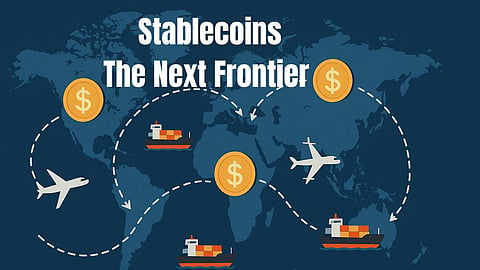From SWIFT to Stablecoin: The Future of Trade Finance Has Arrived
For decades, cross-border trade payments have been plagued by delays, currency conversion losses, and high transaction fees. Now, a new solution is quietly rewriting the rules of global commerce - stablecoins.
Pegged to fiat currencies like the US dollar, these blockchain-based tokens are rapidly becoming the preferred medium for international settlements, outpacing even cryptocurrencies like Bitcoin in trade applications.
Why Stability Matters in Trade
In international logistics and trade finance, price predictability is everything. Importers and exporters work with tight margins and forward contracts, which makes the volatility of traditional cryptocurrencies like Bitcoin a major deterrent.
Stablecoins such as USDC (USD Coin) and USDT (Tether), however, are designed to hold a stable value - usually 1:1 with the US dollar. This eliminates price risk, allowing businesses to invoice, settle, and reconcile payments without worrying about sudden market swings.
Insight: The Promise and Potential of Blockchain in the Supply Chain
The biggest advantage for logistics operators and traders is certainty. With stablecoins, quotes can be sent in digital dollars and settled instantly, avoiding days of banking delays.
Faster, Cheaper and Borderless
Traditional international wire transfers can take two to five business days, often passing through multiple intermediary banks. Each layer adds time, cost, and potential for error.
Stablecoin transactions, by contrast, settle in seconds or minutes, with near-zero fees on blockchains like Tron, Solana, or Polygon. A shipment payment from Dubai to Singapore can now be executed as easily as sending an email.
This speed and cost-efficiency are particularly valuable for small and mid-sized exporters, who often struggle with liquidity constraints and high remittance costs. By using stablecoins, they gain near-instant access to working capital once goods are shipped.
Real-World Adoption Is Accelerating
Across emerging markets, stablecoin use in trade settlements is already gaining traction.
In Latin America, importers in Argentina and Brazil are using Tether (USDT) to pay Asian suppliers, bypassing local currency devaluation and capital controls.
In Africa, logistics firms in Nigeria and Kenya are adopting USD Coin (USDC) for equipment and parts imports, leveraging blockchain networks to move funds faster than SWIFT.
Circle, the issuer of USDC, recently partnered with Visa and Mastercard to allow direct payments in USDC across participating platforms — bringing stablecoin settlements into the mainstream.
These examples point to a growing comfort among regulators and businesses with using blockchain-based stable assets for legitimate trade and logistics payments.
Regulatory Momentum and Integration
Governments and financial institutions are also taking notice.
The Monetary Authority of Singapore (MAS) has been working with Circle and other issuers to test regulated stablecoin transactions for cross-border trade. Similarly, Hong Kong is building frameworks to integrate stablecoins into its trade finance ecosystem.
This regulatory clarity - absent in Bitcoin’s case - is helping stablecoins gain institutional traction. Trade platforms like RippleNet and Stellar already support stablecoin-based settlements for banks and payment providers, while logistics fintechs are exploring blockchain escrow solutions to reduce disputes and delays.
Why Not Bitcoin?
While Bitcoin remains a pioneer of decentralized finance, its volatility, slower settlement (outside of the Lightning Network), and lack of fiat peg make it less suitable for invoicing or operational payments. Many businesses continue to hold Bitcoin as a long-term asset, not a trade currency.
Stablecoins, by contrast, offer the best of both worlds: the speed and transparency of blockchain with the price stability of fiat.
A Digital Dollar Future for Global Trade
As logistics chains digitize and supply chain finance evolves, stablecoins could become the default settlement medium for cross-border commerce. They reduce friction, increase liquidity, and make global trade accessible even to smaller players previously sidelined by banking barriers.
The next wave of innovation will likely see smart contract-based trade payments, where invoices, customs clearances, and settlements are all automated on blockchain - with stablecoins as the fuel of this transformation.
For global traders the message is clear: the future of cross-border payments is stable, digital and blockchain-powered.
Read More: Blockchain at the Docks: How Distributed Ledgers Are Rewiring Global Trade


